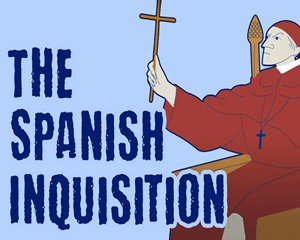It's 1481. In the city of Seville, devout Catholics are turning themselves in to the authorities.
1481年,在西班牙的塞维利亚城,虔诚的天主教徒正在向当局自首。
They're confessing to heresy -- failure to follow the beliefs of the Catholic Church. But why?
他们承认异端,违背了天主教的教义。但是为什么?
The Spanish Inquisition has arrived in Seville.
西班牙宗教审讯所来到了塞维利亚。
The Inquisition began in 1478, when Pope Sixtus IV issued a decree authorizing the Catholic monarchs, Ferdinand and Isabella, to root out heresy in the Spanish kingdoms
宗教审讯开始于1478,教宗西斯科特四世颁布法令,授权天主教君主费迪南德和伊莎贝拉根除西班牙王国的异端邪说,
a confederacy of semi-independent kingdoms in the area that would become the modern country of Spain.
当时该地区的半独立王国联盟是现代西班牙的前身。
Though the order came from the church, the monarchs had requested it.
虽然命令来自于教会,但那也是君主要求的。
When the Inquisition began, the Spanish kingdoms were diverse both ethnically and religiously, with Jews, Muslims, and Christians living in the same regions.
一开始审讯时,西班牙王国有着形形色色的种族和宗教,犹太人、穆斯林、天主教徒居住在同一区域。
The Inquisition quickly turned its attention to ridding the region of people who were not part of the Catholic Church. It would last more than 350 years.
审讯所很快便开始专注于驱除那些非天主教人士,持续超过350年。
On the ground, groups called tribunals ran the Inquisition in each region.
在当地,名为审裁小组的团体掌控了每个区域的审讯所。
Roles on a tribunal could include an arresting constable, a prosecuting attorney, inquisitors to question the accused, and a scribe.
审裁小组包括一位负责逮捕的警察、一位检察官、审问被告的审讯官和一位抄写员。
A "Grand Inquisitor," a member of the clergy selected by the king and queen, almost always led a tribunal.
一位“大审判官”,是一位被国王和王后挑选的神职人员,通常带领审裁。
The Inquisition marked its arrival in each new place with an "Edict of Grace." Typically lasting 40 days, the Edict of Grace promised mercy to those who confess to heresy.
审讯所每到一个地方都会发布“恩典赦令”,通常期限是40天,“恩典赦令”许诺会仁慈对待那些承认异端的人。
After that, the inquisitors persecuted suspected heretics on the basis of anonymous accusations.
在那之后,审讯官便根据匿名指控迫害那些被怀疑的异端们。
So the confessors in Seville probably didn't see themselves as actual heretics
所以,塞维利亚的忏悔者未必认为自己真的是异端,
instead, they were hedging their bets by reporting themselves when the consequences were low, rather than risking imprisonment or torture if someone else accused them later on.
而是赌,在后果尚不严重时便自我上报,免得往后一旦别人指认他们会被监禁或刑求。
They were right to worry: once the authorities arrested someone, accusations were often vague,
他们的担忧没有错:一旦当局逮捕了某些人,控告通常是模糊的,
so the accused didn't know the reasons for their arrest or the identity of their accuser.
所以被控告的人不知道他们为何被逮捕,也不知道控告者的身份。
Victims were imprisoned for months or even years. Once arrested, their property was confiscated, often leaving their families on the street.
受害者受到长达几个月或者几年的监禁。一旦被逮捕,财产就被没收,以至于他们的家人无家可归。
Under these conditions, victims confessed to the most mundane forms of heresy -- like hanging linen to dry on a Saturday.
在这样的情况下,受害者承认最平凡的异端形式--例如在星期六晾晒床单。

The Inquisition targeted different subsets of the population over time.
审讯所逐渐针对人口中的不同团体。
In 1492, at the brutal Grand Inquisitor Tomás de Torquemada's urging,
1492年,在残忍的大审判官托马斯·德·托尔克马达的催促下,
the monarchs issued a decree giving Spanish Jews four months to either convert to Christianity or leave the kingdom.
君主发布一条法令,命令西班牙犹太人要么在四个月内改信天主教,要么离开西班牙。
Thousands were expelled and those who stayed risked persecution.
上千人被驱逐,那些留下来的则有被迫害的风险。
Converts to Christianity, known as conversos, weren't even safe, because authorities suspected them of practicing Judaism in secret.
改信天主教的人被称为改宗者,也不安全,因为当局怀疑他们秘密地信奉犹太教。
The hatred directed at conversos was both religious and economic, as conversos made up a large portion of the upper middle class.
改宗者们受到了宗教与经济性的敌意,因为他们很大一部分是中上阶级。
The Inquisition eventually shifted its focus to the moriscos, converts to Christianity from Islam.
审讯所关注的中心最终转移到了莫里斯科人,从伊斯兰教转信基督教的人。
In 1609, an edict passed forcing all moriscos to leave. An estimated 300,000 left. Those who remained became the Inquisition's next targets.
1609年,一则法令强迫所有的莫里斯科人离开西班牙。估计三十万人离开了。那些留下来的人成为了审讯所下一个针对对象。
The inquisitors announced the punishments of those found guilty of heresy in public gatherings called autos de fé, or acts of faith.
审判官在公共集会上宣布惩罚那些犯有异端罪的人,称为autos de fé或信仰的行为。
Hundreds of people gathered to watch the procession of sinners, mass, sermon, and finally the announcement of punishments.
上百人围观充斥着罪人、弥撒、布道的游行,以及最终处罚的宣告。
Most of the accused received punishments like imprisonment, exile, or having to wear a sanbenito, a garment that marked them as a sinner.
大部分被告被罚监禁、流放,或穿悔罪服--标记罪人的服装。
The worst punishment was "relaxado en persona" -- a euphemism for burning at the stake.
最糟的处罚是“relaxado en persona”--火刑的委婉说法。
This punishment was relatively uncommon -- reserved for unrepentant and relapsed heretics.
这种处罚不是很常见,留给不悔悟和复发的异端。
Over 350 years after Queen Isabella started the Inquisition, her namesake, Queen Isabella II, formally ended it on July 15th, 1834.
在伊莎贝拉女王开始审讯所的350多年后,与她同名的伊莎贝拉二世女王在1834年的7月15日正式终止审讯所。
The Spanish kingdoms' dependence on the Catholic Church had isolated them while the rest of Europe experienced the Enlightenment and embraced the separation of church and state.
西班牙王国对天主教教会的依赖使得其孤立,那期间其他的欧洲国家经历启蒙运动,接受政教分离。
Historians still debate the number of people killed during the Inquisition. Some suggest over 30,000 but most estimate between 1,000 and 2,000.
历史家们仍然在争论因为审讯所而死亡的人数。有些人认为死亡人数超过三万人,但是大部分人估计大约在一到两千之间。
The consequences of the Inquisition, however, reach far beyond fatalities. In some places, an estimated 1/3 of prisoners were tortured.
然而审讯所带来的后果远远超过死亡人数。有些地方估计1/3的囚犯被刑求。
Hundreds of thousands of members of religious minorities were forced to leave their homes, and those who remained faced discrimination and economic hardship.
成千上万的宗教少数派被强迫离开家园,留下来的面临歧视和经济困境。
Smaller inquisitions in Spanish colonial territories in the Americas, especially Mexico, carried their own tolls.
在美洲的较小型的审讯所,尤其是墨西哥,也受到了影响。
Friends turned in friends, neighbors accused neighbors, and even family members reported each other of heresy.
朋友反目,邻居互相控告,甚至家庭成员控告彼此是异端。
Under the Inquisition, people were condemned to live in fear and paranoia for centuries.
审讯之下,几个世纪的人被罚而活在恐惧中。












